|
The Los Angeles Aqueduct
Before
the turn of the 19th century, officials realized the Los Angeles River
could only accommodate 300,000 people. The mayor of Los Angeles, Fred
Eaton, originally proposed the Owens Valley as a water supply in 1893,
but William Mulholland, the head of the Water Department, thought
it was unrealistic. Eaton decided to purchase land options in the
valley on his own, and when it was finally chosen as a new supply,
Eaton decided to make money for himself from the city. Mulholland
and the city attorneys put Eaton off for 3 years and finally made
a deal to purchase the land for ¼ of Eaton's original offer.
|
|
|
|
William
Mulholland, 1924
Los Angeles Examiner collection
USC Regional History Center
|
Fred
Eaton
Security Pacific Historical Photograph Collection
Hundley, The Great Thirst, p. 145
|
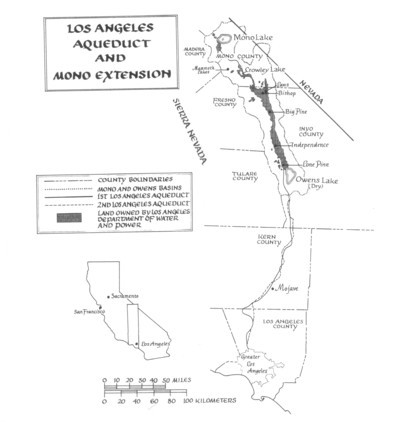
The Los Angeles Aqueduct
System
Hundley, The Great Thirst, p. 159
Back
to Top
Past,
Present, Future
Congress declared
the Owens Valley aqueduct a reclamation project and construction was
begun in 1908 and completed in 1913. Over 30,000 residents watched
as the first water was released into the San Fernando Valley on November
5, 1913. Scandal broke when a water board member alerted several rich
industrialists of the coming of the aqueduct and they purchased land
options in the San Fernando Valley for $50,000 that would later be
worth millions. Fred Eaton slowly went insane and died in 1934, his
family bankrupt from his many money making schemes. William Mulholland
died in 1935. Many people wrongly blamed him for the Otis-Sherman-Huntington
land syndicate, the collapse of the St. Francis Dam, and making a
fortune from water. In the 1990's, the DWP softened its hard-lined
position and admitted it was in $7.5 billion in debt. Decades of manufacturing
of all kinds caused groundwater contamination with TCE, PCE, MTBE
and perchlorate.
|
|
|
|
Opening
the aqueduct into San Fernando Valley, 11/5/1913
Los Angeles Department of Water and Power
Hundley, The Great Thirst, pp. 156, 157
|
Back
to Top
So
What?
- Owens Valley residents felt betrayed by
the City of Los Angeles and the federal government. Owens Lake dried
up and Mono Lake began losing water. The dry Owens Lake bed caused
many dust storms and the particles are a health hazard.
- The aqueduct was dynamited and gates were diverted several times
- St. Francis Dam was built to hold extra water. Mulholland was the
engineer, and it collapsed midnight March 13, 1928. 500 people died.
- Southern California consumption of bottled water increased 300%
in the 1990's.
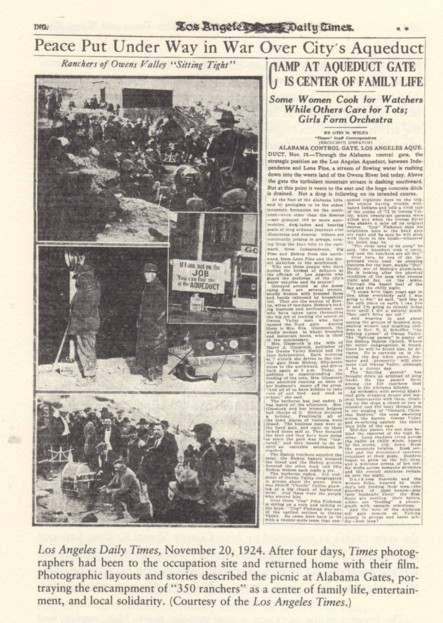
Alabama Gates Occupation
Walton, Western Times and Water Wars, p. 163
From The
Los Angeles Daily Times
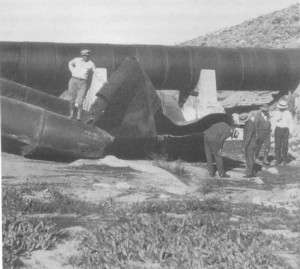
The aqueduct dynamited in 1927
Security Pacific Historical Photograph Collection
Hundley, The Great Thirst, p. 164
|
|
|
The
St. Francis Dam
Between 1926 and 1928
Los Angeles Department of Water and Power
|
|
|
|
March
13, 1928-the day of collapse
Photo by Underwood and Underwood,
Security Bank Collection
|
|
|
|
Today-remains
of the dam are just to the right of the road
Photo by Frank Rock, 2001
Santa Clarita Historical Society
|
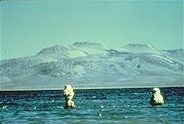 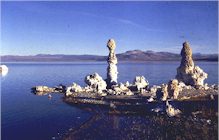 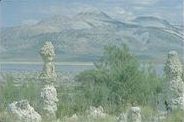
Mono Lake - 1962,
1968 and 1995
http://www.monolake.org/politicalhistory/index.html
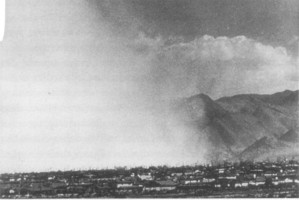
Owens Lake dust storm,
1979
Great Basin Unified Air Pollution Control District
Hundley, The Great Thirst, p. 354
Back
to Top
Los
Angeles 's water responsibilities:
- To replenish Owens Lake and win back public trust
- To its own fiscal health
- Eliminating toxins in groundwater
|